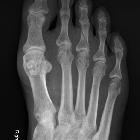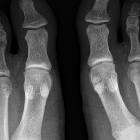Multipartite hallux sesamoid

Os
sesamoideum hallucis multipartum. Es lassen sich 4 getrennte Knochenkerne des medialen Sesambeins am Metatarsale-I-Köpfchen identifizieren.



Multipartite
hallux sesamoid • Bipartite hallux sesamoid - Ganzer Fall bei Radiopaedia

Multipartite
hallux sesamoid • Bipartite hallux sesamoid - Ganzer Fall bei Radiopaedia

Multipartite
hallux sesamoid • Tripartite medial hallux sesamoid bone - Ganzer Fall bei Radiopaedia

Multipartite
hallux sesamoid • Fractured lateral and bipartite medial hallux sesamoid bones - Ganzer Fall bei Radiopaedia

Multipartite
hallux sesamoid • Multipartite hallux sesamoid - Ganzer Fall bei Radiopaedia

Multipartite
hallux sesamoid • Bipartite hallux sesamoid - Ganzer Fall bei Radiopaedia

Multipartite
hallux sesamoid • Bipartite medial hallux sesamoid - Ganzer Fall bei Radiopaedia

Geteiltes
Sesambein Os-metatarsale-I-Köpfchen medial, ein häufiger, nicht pathologischer Befund.

Multipartite hallux sesamoids are a commonly seen normal variant, present in up to 33% of hallux sesamoids. They are more commonly bipartite than tripartite.
The medial (tibial) sesamoid is more likely to be multipartite than the lateral (fibular) sesamoid because it more commonly has more than one ossification center. Bipartite hallux sesamoids are bilateral in ~70% (range 50-85%) of cases.
Differential diagnosis
The principal differential diagnosis is a hallux sesamoid fracture. It can be difficult to differentiate because bipartite hallux sesamoids are more likely to fracture than complete hallux sesamoids. Features that support a bipartite over a fractured sesamoid include:
- transverse lucency
- smooth, well-corticated margins
- sum of the two parts is greater than the adjacent (and hopefully normal) sesamoid
Siehe auch:
- Sprinteraufnahme Sesambein D1 tangential
- Sesambeine des Fußes
- Os sesamoideum hallucis
- Os sesamoideum multipartum
und weiter:

 Assoziationen und Differentialdiagnosen zu geteiltes Sesambein am Hallux:
Assoziationen und Differentialdiagnosen zu geteiltes Sesambein am Hallux:
